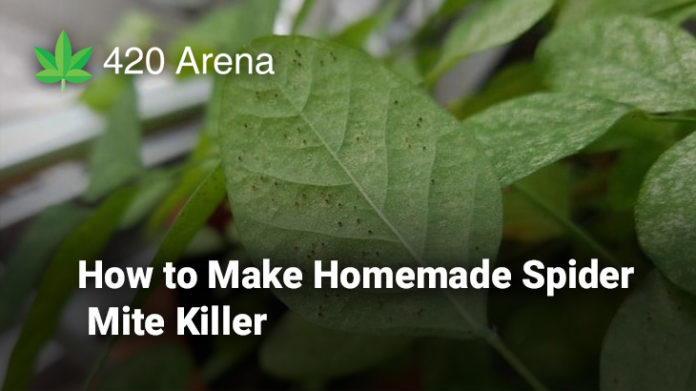Marijuana, much like practically any other plant, can be grown indoors as well as outdoors. Some growers prefer to grow their weed indoors so that they can create ideal situations for growth but there are others who choose to grow it the all-natural old-fashioned way – under the skies. Growing plants outdoors has a number of benefits but one big problem that this method of growth tends to face is that there are a number of insects and pests which may infest your plant and cause damage to an otherwise healthy plant! Spider Mites happen to be one such major problem for growers.
Over the course of this article, we shall be discussing everything that there is to know about spider mites – how they infest your plants, how they breed, etc. However, most importantly we will tell you about how you can get rid of these insects! The biggest problem with most spider mites attacks is that they are usually never a one-off thing. Once your plant gets infested by them there’s a good chance you might just face another attack soon enough. Hence, you need a reliable solution to this problem.
It is essential for growers to know about the dangers of growing outdoors and attacks by pests. Here’s a quick look into that:
Growing Indoors vs Growing Outdoors: Attack of Insects Pests
There are two schools of thoughts when it comes to growing weed. The old-fashioned growers want their plants to grow outdoors under nature and via ‘all-natural’ means including organic techniques. However, of late there have been an increasing number of growers who like to grow their plants indoors by providing them with artificial recreations of these natural sources such as sunlight, ventilation, nutrition, etc.
The latter groups of people claim that when you grow your plants indoors, you are allowing them to grow in the best possible conditions. Growing indoors allows you to adjust the lighting conditions to such that your plants would get an optimum amount of sunlight during different phases of their growth – you can also adjust various other factors such as the temperature that your plants grow in, the kind of soil and nutrients that they are getting, etc. However – the biggest difference is about protection. When you grow indoors, your plants remain protected from a lot of other threats that they would usually not be safe from while you grow them outdoors.
This includes the threat of bad weather – in case of extra rain or snow your plants might not be able to survive for long. Another similar example of a natural threat is that of animals, insects, and pests! Insect and pest invasion could ruin a happy garden in just a few hours and you need to be extremely careful about that when growing outdoors. Pests such as spider mites tend to look tiny but are very dangerous and can destroy your crops so you need to watch out for them.
What are Spider Mites?
Let us now address the main topic at hand – what are spider mites, how do you identify them, and then most importantly, how to make homemade spider mite killer to make sure that these pests do not infest your marijuana anymore! However, before all of that, let us first talk about what these insects actually are.
Spider Mites, technically speaking, are mites of the Tetranychidae family of insects in which there are over 1200 members. However, this is one of the most commonly found insects in gardens. While it is bad enough in small numbers, it can be extremely dangerous if found in large numbers! Many times they have been found indoors too – but usually attack outdoor plants. Greenhouse owners are at a special risk because once a large enough population of these mites develops in a greenhouse, you’re certain to face major damage!
While we commonly call them as insects, they belong to the arachnid family of animals which include spiders and ticks. Let us now take a closer look at them and see how you can identify them and how can you get rid of them:
How to Identify Spider Mites?
The most basic thing that you need to know about spider mites is somewhat obvious. They look like tiny spiders. You will usually find them crawling over your plants in the summer seasons – especially the drier days of summer. These are some of the most common sorts of pests that can be found in a garden and are known to infest at least 180 different types of plants. The biggest problem that comes with identifying these sort of mites is that they are so small that you would perhaps need a magnifying glass to see them! They are only about 1/20th of an inch in length. To the naked eye, they resemble tiny dots which are just moving around. Just in case it interests you, the female spider mites tend to be bigger in size than compared to their male counterparts.
One of the best ways to identify spider mites is to look for signs of their infestation. If you suddenly find yellow spots or pale spots appearing on large portions of your plants, then that is one reason to worry and you need to start checking with a magnifying glass to see if spider mites are present. One of the most prominent signs of the fact that your plant is being attacked by spider mites is that there will be small webbings present on it! These webbings will be spotted on the lower portions of your leaves and on branches and nodes.
Life Cycle of Spider Mites
Winter is the mating season of spider mites. This is the time when they mate and they lay their eggs which go dormant over the colder months. However, come spring these eggs begin to hatch and a whole new batch of spider mites will be ready to infest your plants! These eggs might lay hidden in the soil so you’ll never know if they are there until they actually begin to attack your plants. They hatch from the eggs and are at that time six-legged larvae, which mature into eight-legged nymphs over the course of time as warmth increases. What makes them really huge breeders is the fact that one spider mite can lay about 300 eggs – and even if half of them actually grow up into spider mites they can still ruin your plants in the next season!
How to Make Homemade Spider Mite Killer?
Now that you know everything that there is to know about spider mites – what they are, how to identify them and how they grow, let us take a closer look at the solutions too! These methods are made out of things that you would find in your home at any regular day or can procure them easily to make the final mix. How to get rice of spider mites is one of the biggest questions that people want an answer to and here are some amazing home remedies which will help you deal with them.
1. Using Insecticidal Soap
The use of insecticidal soaps is one of the best and the most popular methods of getting rid of spider mites. This method also works when it comes to getting rid of other common insects that affect plants such as aphids, etc and is a very effective homemade spider mite killer. You simply need a soap which is non-detergent and non-degreaser in nature and mix one tablespoon of this soap with 4 cups of water. The mixture that is produced here can then be filled in a pressurized spray bottle and then sprayed over the plants’ leaves. Let the solution remain there for at least two to three hours before you begin to wipe off. Ideally if you keep doing this for one whole week your spider mite problem should be resolved!
2. Using Neem Oil
Neem Oil is another popular and very effective method of controlling pests and insects. This is an ancient technique which has been in use for thousands of years! There are a number of medicinal benefits of Neem Oil as well which ancient cultures have benefited from. You will need to buy a bottle of neem oil for this, then mix it up with water. Fill the solution in a spray bottle once again and begin to spray it on your plants. Be generous with your spraying and ensure that the entire plant is covered in this solution. Neem Oil is very effective against eliminating spider mites and is one of the best options for growers who want to make homemade spider mite killer.
3. Using Garlic Spray
Garlic! Mythologically known to be effective against vampires, using a garlic spray would also be a very effective means to ward off these spider mites. This is another popular way to make homemade spider mite killer which will get your plants pest free in no time! You will need a clove of garlic which has to be blended along with two cups of water. You will know it has been successfully done when the solution of garlic and water is no longer powdery and appears to be smooth. Store it for about a day in a place which is neither hot nor humid. Then, use a strainer to pour the solution into a new vessel and add about 12 cups of water to it so that this mix can be diluted. A pro tip is to mix the first type of homemade spider mite killer (the soap) along with this to make an even stronger solution that would ensure that the mites disappear from your plants.
Frequently Asked Questions About Spider Mites
These are the answers to some of the most common and frequently asked questions about spider mites that growers have asked us in the past. Do go through them carefully as you too might have a similar question:
1. Are there any positive effects of spider mites?
While a number of insects and pests that affect your plant tend to leave some positive impacts upon the plant, spider mites are completely harmful and have no benefits at all.
2. Do spider mites also affect indoor growth?
Spider mites are commonly found outdoors but they can make their way indoors too, especially when you are moving your plants in for summer or during the rainy season and those plants have these pests on them. In that case they can get indoors and then spread faster because of ideal conditions. However, if you are growing a plant indoors from the beginning (especially in a protective layer such as a grow tent) then there are limited chances of these pests appearing.
3. How do they damage my plants?
Spider mites pierce through the leaf using tiny and sharp tentacular structures that they have on their mouth to break the cellular lining of the plant and feed on the liquids stored in leaves. Wherever these mites feed, they leave a light yellow coloration behind. If caught early and treated well, spider mite attacks can have a reversible effect and the plant can heal – but if it gets too late certain portions of the plant might never really be able to recover from these attacks!
Conclusion
We hope that this article has helped you learn much more about spider mites than you did in the past! These pests tend to be quite irritating and can damage your plants if you do not control them in time. The biggest problem with spider mites is that you never know if they are really gone and will not attack your plant again. Some of our methods help you with that. There are a number of homemade spider mite killer techniques that you can use as we have mentioned here which will help you get rid of them faster and in a more effective manner! If you have any other queries about spider mites or even about other kinds of pests, do let us know in the comments or drop us a mail and we shall get back to you soon! Till then…
…Happy Growing! 🙂
Table of Contents

















![How to Use Carbon Filters in Your Grow Room [7 Best Carbon Filters for Grow Rooms in 2021] How to Use Carbon Filters in Your Grow Room](https://420arena.com/wp-content/uploads/2020/12/How-to-Use-Carbon-Filters-in-Your-Grow-Room-218x150.jpg)










